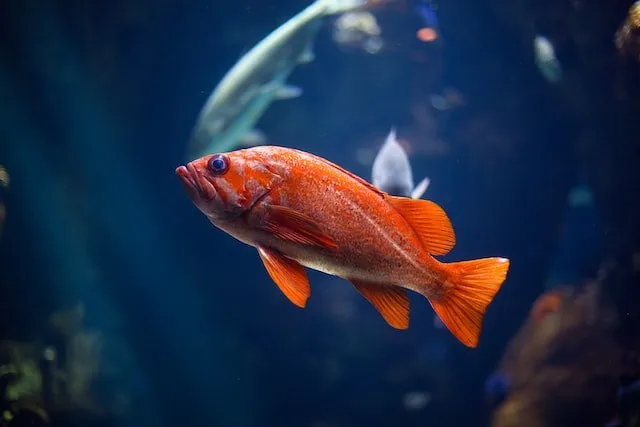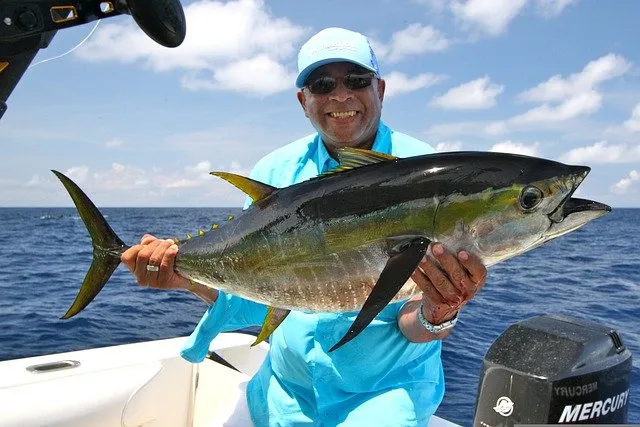As an Amazon Associate I earn from qualifying purchases.
Yellowfin tunas are among the smaller tunas, reaching a maximum size of around 180 cm (71 in) and weighing up to 90 kg (200 lb). They have yellowfins and a dark blue body, with golden spots scattered on their sides. Their head has an elongated shape. They prefer temperate and tropical waters and can be found in the Atlantic, Pacific, and Indian Oceans. They commonly school with other tunas such as bigeye tuna and skipjack tuna. So, what do yellowfin tuna eat? Will discuss more about it later.
Yellowfin tunas are among the fastest swimmers of all fish, reaching speeds of up to 50 km/h (31 mph). Their diet consists mostly of small fishes, squid, and crustaceans. They are important commercial fish, with major fisheries in the western Pacific and Indian Oceans. In some areas, they are considered to be overfished.
What Do Yellowfin Tuna Eat?
Yellowfin tuna are predators that consume a variety of other marine life. Their diet depends on age, size, and location, but they typically eat fish, squid, shrimp, and crabs. Smaller yellowfin tuna may also eat plankton and krill. Yellowfin tuna are opportunistic feeders that hunt using their keen eyesight and sense of smell.
They typically travel in schools and hunt cooperatively, using their speed and agility to herd their prey into tight groups before attacking. Once they have caught their prey, they use their sharp teeth to tear it apart. Yellowfin tuna are an important species in the marine food web, and their populations are currently threatened by overfishing and habitat loss. Here are some foods that yellowfin tuna commonly eat:
1.Small fish:
Yellowfin tuna is a type of fish that typically eat other, smaller fish. Yellowfin tuna are found in tropical and subtropical waters worldwide, and they typically prefer reefs or areas with high concentrations of small fish. Yellowfin tuna are predators, using their sharp teeth to capture and eat their prey. Yellowfin tuna typically eat small pelagic fish, such as sardines, anchovies, and herring.
2.Squid:
Squid is a common food source for yellowfin tuna. Yellowfin tuna are found in tropical and subtropical waters worldwide and typically hunt in areas with high concentrations of squid. Squid is an important food source for yellowfin tuna because they are high in protein and low in fat. Yellowfin tuna use their sharp teeth to capture and eat squid.
3.Shrimp:
Yellowfin tuna also eat shrimp. This is because Yellowfin tuna are opportunistic feeders and will eat whatever type of food is available to them. Yellowfin tuna typically hunt in groups, using their speed and agility to ambush their prey. Once they have caught their prey, they use their sharp teeth to tear it apart. Shrimp is a good source of protein for yellowfin tuna.
4.Crabs:
One type of crustacean that yellowfin tuna often eat is crabs. Crabs are a nutritious and protein-rich food source for yellowfin tuna, providing them with essential nutrients that help them to grow and stay healthy. Yellowfin tuna typically eat small crabs but have been known to consume larger crabs occasionally. When hunting for crabs, yellowfin tuna use their keen sense of smell to track down their prey. Once they have located a crab, they use their sharp teeth to tear it apart and consume it.
5.Plankton:
Yellowfin tuna are predators that hunt in the open ocean, far from the coast. They eat a variety of prey, but their primary diet is small fish and squid. When yellowfin tuna are young, they also consume large amounts of plankton. Plankton is tiny organisms that drift in the ocean’s currents. They include both plant life and animals and play an important role in the marine food chain. Yellowfin tuna use their sharp eyesight and sense of smell to locate plankton near the water’s surface. Then they swim quickly up to feed, using their large mouths to filter plankton from the water. This feeding behavior helps yellowfin tuna grow quickly and ensures that they have enough energy to pursue their fast-moving prey.
6.Krill
Yellowfin tuna hunt krill in open water, using their streamlined bodies and powerful tails to swim at high speeds. When they spot a school of krill, they charge in and eat as many as possible before swimming away again. Yellowfin tuna plays an important role in the ocean food chain, and their continued survival is crucial to the health of the world’s oceans.
What Eats Yellowfin Tunas?
Yellowfin tunas are a type of fish that many people enjoy eating. They are found in tropical and subtropical waters worldwide and are popular for sushi and sashimi. While humans often catch them for food, they are also preyed upon by several other animals.
Some of the most common predators of yellowfin tunas include sharks, billfish, and dolphins. These animals are all fast swimmers that can easily catch and eat tunas. Other predators include tuna seabirds, which dive into the water to catch their prey, and marine mammals such as whales and seals, which eat fish as part of their diet. Yellowfin tunas are also sometimes eaten by squid and jellyfish.
One of the main dangers yellowfin tunas faces is being caught and eaten by another animal. As a result, they have evolved to be very fast swimmers to escape from their predators. However, even with their speed, they can still not always avoid being eaten.
How Do Yellowfin Tunas Help Our Ecosystem?
Well, to start with, they are a significant food source for predators like billfish, swordfish, and sharks. They are also important commercial fish, with their meat being used for canning, steaks, and sushi.
Yellowfin tunas are also a key component in the ocean’s carbon cycle. When they die and decompose, their bodies sink to the seafloor and become part of the ocean’s sediment. There, they act as a carbon sink, helping to remove carbon from the atmosphere and sequester it in the deep sea.
This helps to moderate climate change by reducing the number of greenhouse gases in the atmosphere. So, as you can see, Yellowfin tunas play an important role in our ecosystem and deserve our protection.
Wrapping Up
In conclusion, yellowfin tunas can eat various things, including small fish, squid, and plankton. They are predators hunted by many other animals, including sharks, dolphins, and whales. Despite being preyed upon by so many animals, they are still a key component in the ocean’s food chain and play an important role in our ecosystem.
You can also read:
What Do Baby Grubs Eat? An In-Depth Guide
What Do Red Fire Ants Eat? 7 Foods They Eat
What Do Fire Ants Eat? A Complete Guide
What Do Black Garden Snakes Eat?
Amazon and the Amazon logo are trademarks of Amazon.com, Inc, or its affiliates.



